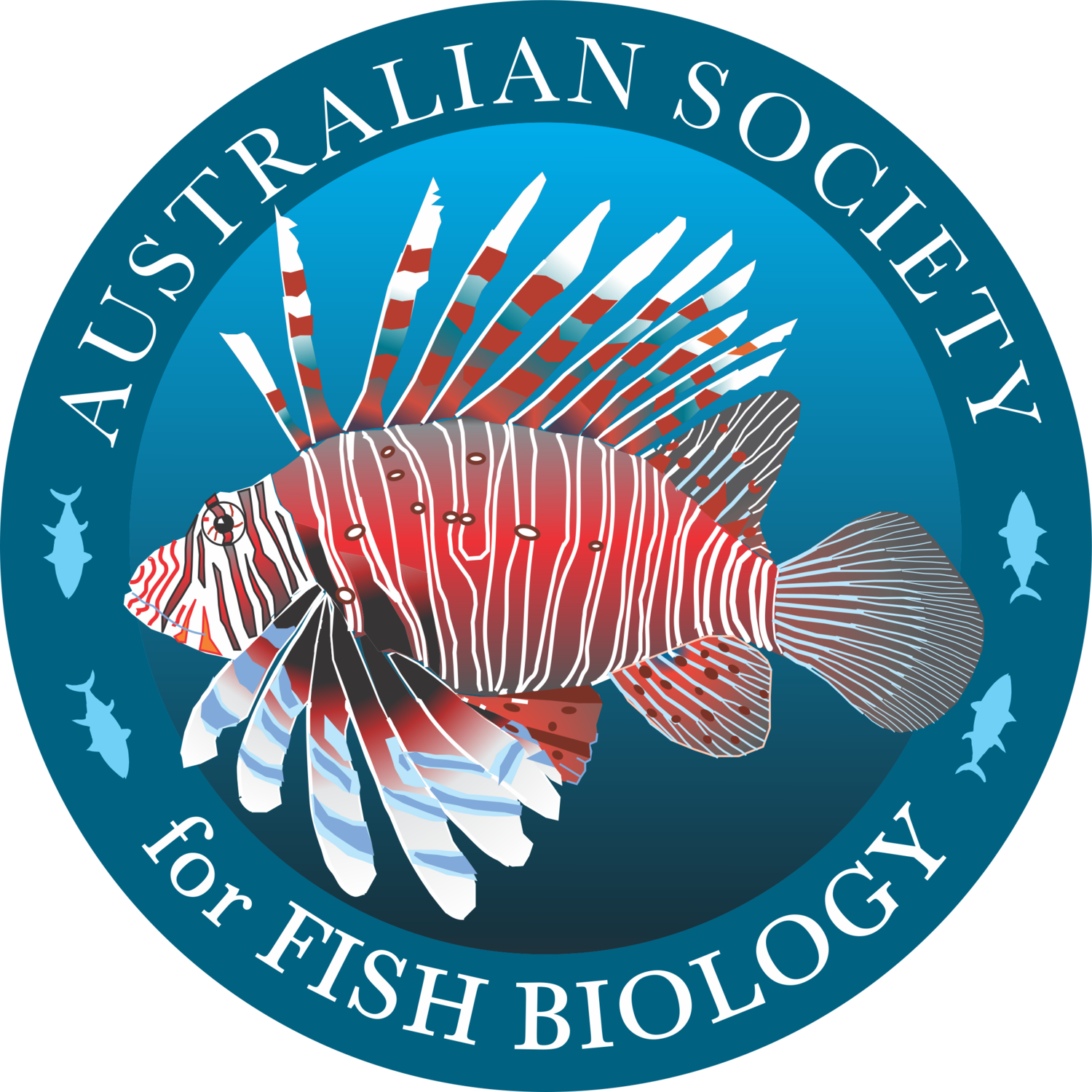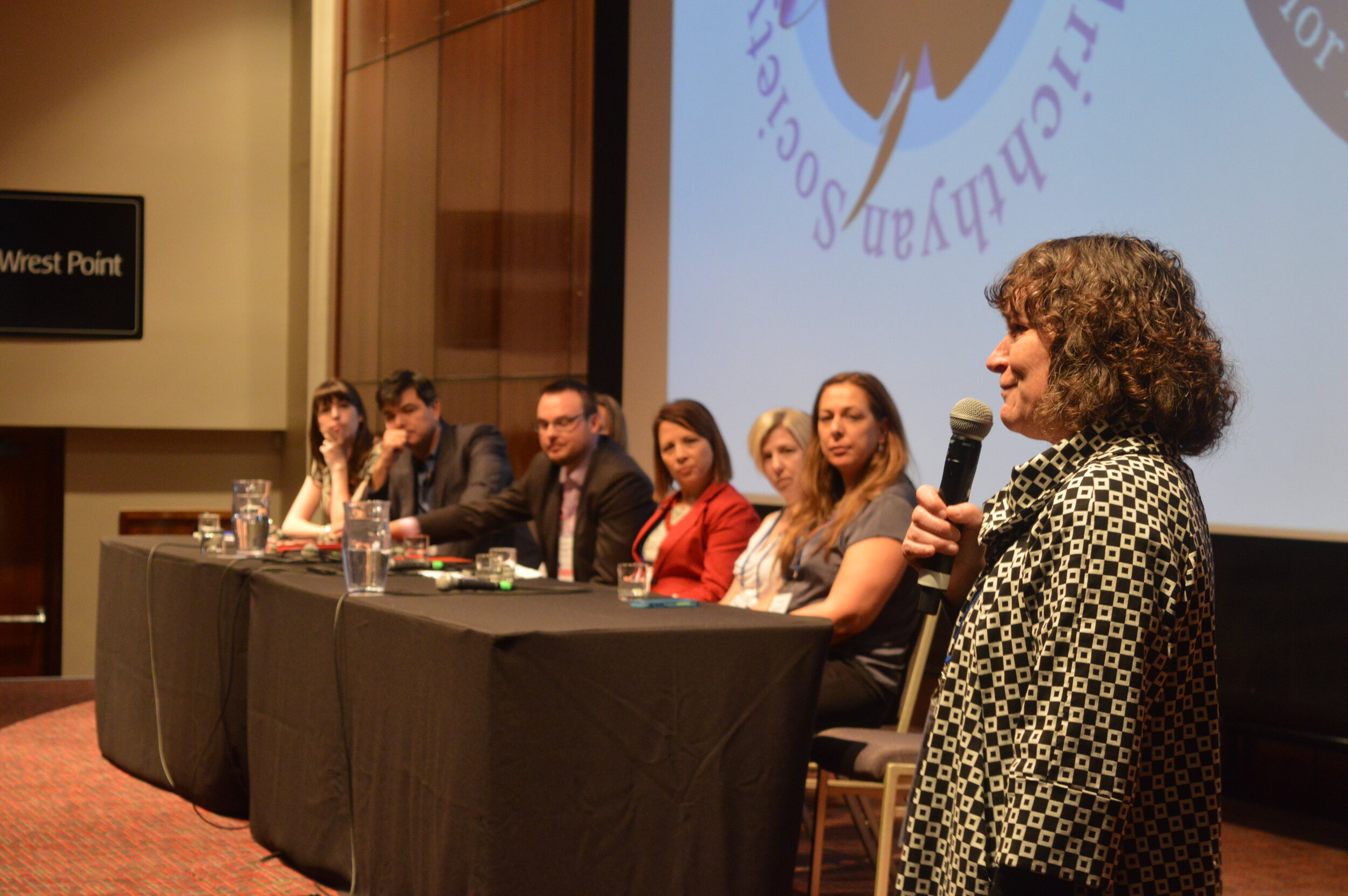50 years of memories
ASFB members, past and present, share their favourite memories of the society.
Bronwyn Gillanders speaks at the “Women in Ichthyology” keynote session at the 2016 joint ASFB-OCS conference in Hobart, Tasmania. © Andrew Katsis
A pretty special memory was seeing my PhD supervisor Mike Kingsford get the K. Radway Allen Award. He gave the presentation at my first ASFB conference (Melbourne 2018), which was a fitting way to see how researchers follow in each other’s footsteps. Mike spoke about his mentors, as well as the post-docs and students he guided along the way. There were some great throwback pictures! It was my very last conference as a PhD student, and also a great reunion with past lab-mates April Boaden Hall and Kynan Hartog-Burnett and other JCU alums. I think we often forget how mentorship begets both a social and a professional legacy. It was a privilege to see him receive that honour from ASFB and be surrounded by colleagues and students past and present.
Tiffany Sih
In February 1979, having arrived in Australia to take up my position as Curator of Fishes at the then National Museum of Victoria, I set out to make my way in this brave new world. I had just completed the qualifications for a PhD, and, over my rather lengthy student career, had come to appreciate the importance of developing networks and establishing links with important players in my field. It had become clear that top professional societies, and, in my case, the American Society for Ichthyologists and Herpetologists, were vital avenues for doing this. A quick whip around to colleagues at museums in Australia, whom I had come to know via tedious snail mail, identified the Australian Society for Fish Biology as the closest equivalent. It actually appeared to be an amalgam of what in the States is the ASIH – an academically oriented aggregation – and the American Fisheries Society focusing on the industrial side, two enormous societies. I quickly joined and signed up to attend my first conference in Port Stevens with expectations based on my experiences at the ASIH conferences. They are extremely formal affairs with the quintessential dichotomy between long-established icons of the disciplines and the yet-to-be-proven larval members. Certainly, interactions between the two do occur, but they invariably take place post formal sessions, often at a local watering hole and usually based on prior introductions. To my great delight, the Australian version proved to be far more casual and welcoming, with even a bit of humour creeping into no less professional oral presentations. The final Sunday barbeque at the fisheries station was a sealer, with endless food and beverage literally flowing throughout the space. I was hooked.
Martin Gomon
I’ve attended a few ASFB conferences now, always finding them enjoyable. However, my personality often has me standing in the back row of crowds, always polite and willing to chat, but often feeling like an ‘outsider’ in a room full of intellectuals. Something changed in 2019 at Canberra. I arrived late to the venue for the opening ceremony; my anxiety levels rose as I entered the room full of raucous banter. I signed in, and, as usual for me, skirted to the back of the crowd to observe proceedings. Straight away, I noticed a familiar face in Brendan Ebner making a beeline toward me with a cold beer in hand—“Here you go mate, saw you come in, have a beer and we’ll catch up later”—and, with that, he turned to re-join the crowd. In an instant, I felt like part of the ASFB family, and, with that small gesture, that feeling of being an outsider had gone. I don’t remember much of the opening speeches. I just stood there with a smile on my face and a cold beer in my hand, thanks to Ebb, and the thought that this was going to be a great conference. Can’t wait for my next one and to see the friendly faces again.
David T. Roberts
An unforgettable experience was winning the ASFB Video Competition in Science Communication in 2020. This is special to me, since it was my first time entering any video competition. I talked for three minutes on my ongoing Ph.D. research, which focuses on egg and embryo technologies of redclaw crayfish for commercial juvenile production. Through this event, I also had opportunities to learn about other interesting studies. Though I won the senior student award based on the judges’ choice, the competition was open for online voting. The exciting part was I circulated my video to social media such as Facebook and LinkedIn, and thus my study came to more people's knowledge and improved social networking. I felt privileged to be a participant, as well as a winner, in such a wonderful science competition arranged by ASFB that improved my intrinsic motivation and brought value to my research.
Nur Un Nesa
Why attend the ASFB annual conference?
What I really want to learn while at the ASFB conference is what my colleagues are doing now, or, better yet, planning to do. These are at least as interesting, if not more so, than the short, polished oral presentations. It is only here at ASFB where you learn where the field is going, rather than where it has been.
Meeting and chatting with the 'big names' in your field is a major reason to attend the ASFB conference. Of course, catching up with old friends and colleagues, and meeting the bright, young upcoming researchers is a big drawcard, too. In short, making connections.
I have an aversion to the mammoth international conferences with many thousands of people in attendance. I find it frustrating that so many of the presentations I want to hear are on at the same time as others I want to hear. Also, there is never an opportunity to attend talks that are not absolutely within my own field – maybe my interests are too broad, but I think it makes me a better scientist to engage with research results and approaches from other, related fields. One piece of advice I always give to young people (only when asked, of course!) is to get as wide a background as you can in areas that are related to or potentially related to your own field. I think my postgraduate training as an oceanographer (in the American sense: there are biological oceanographers, chemical oceanographers, physical oceanographers, etc.) has been extremely valuable and has enabled me to make contributions in a variety of areas.
Now, what does the previous paragraph have to do with attending the ASFB conference? One of the things I most appreciate about the ASFB conference is its size – not too small, and not too large.
Jeff Leis
As part of the 2018 ASFB conference in Melbourne, I organised a national online poll to crown Australia's favourite fish species. Conference chair John Morrongiello introduced the poll on day one of the conference, and I provided real-time voting updates every morning. It created a real buzz for the conference: many delegates were campaigning for their study species, and I received multiple emails from grumpy blackfish enthusiasts who disagreed with their species' exclusion from the shortlist. Ultimately, after a hard-fought campaign, the leafy seadragon (Phycodurus eques) was crowned Australia's favourite, with 132 votes (from nearly 1,200 cast in total).
Andrew Katsis
The informality of Australians and their friendly approach to life and the world is certainly reflected in the Australian Society for Fish Biology. From my first attendance at an annual conference (Narrandera, early 1980s), I was warmly welcomed, enjoyed the camaraderie, and had lots of laughs. Behind the fun and ‘play hard’, however, was considerable hard work. Hard work from individual professional fish scientists, both within their institutions and in running ASFB. They provided great inspiration, role models and mentoring. ASFB was a vital platform through which a young scientist could engage with them and view their science. The annual conferences remain a key touch point for catching up with colleagues and the latest science. It is hard to pick a favourite conference (estimate I have attended 30+), as each has their own personality as they rotate around the country. Large or small, city or country, they always seem jam-packed with new science ideas and entertainment. In the past, they were probably wilder, with some wild personalities with some memorable, often crazy CH3CH2OH-fuelled antics amongst -hour festivities. High-quality conferences, workshops and symposia, often linked to international events with other organisations, allow interactions with Australia’s best fish scientists and the inspirational international keynote speakers, providing a world perspective for all. ASFB has provided me with lots of opportunities and connections, and also the opportunity ‘give back’ to the Society, especially helping younger members. The science and the friendships keep me coming back after nearly four decades!
John Koehn
I have very fond memories of ASFB conferences and a quite a few highlights. ASFB was one of the first ‘proper’ conferences I attended — back in the days you had photos developed, printed, and then stuck them on manually on to card !!), and then there were a few conferences with babies in tow, and a keynote almost exactly 20 years after my very first ASFB conference. But the best highlights would have to be conferences where your students present their work, and get great feedback, or even win prizes.
Gretta Pecl
I became the society's Communications Manager in 2015, despite having no prior experience with fish research. As an ornithologist at my very first ASFB conference, I initially felt very much like a fish out of water (sorry). Every time I tried to explain my PhD research, the other person would nod along politely for several minutes, look confused about my research methods, and then finally exclaim, "Oh, zebra FINCH! Not zebrafish." However, it didn't take long for me to feel welcome amongst the fish folk. Chris Fulton, then the ASFB President (and hence my boss), seemed genuinely excited to meet me for the first time, after a year of email correspondence. I spent three busy days writing blog articles, interviewing conference attendees, and posting on social media. The 'Women in Ichthyology' session was a huge online hit, trending on Twitter at #8 in Australia and #5 in New Zealand.
Andrew Katsis

